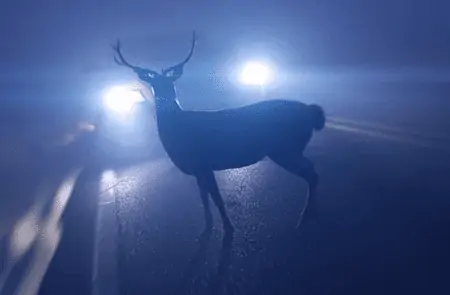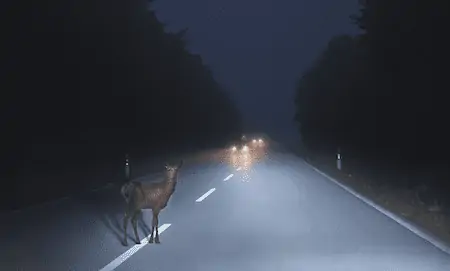Have you ever driven on a country road on a cold night? If you have, then it’s more likely that you have had at least one deer encounter in the road. When you drive with your headlights ON, have you noticed that the deer get frozen in the headlights?
Yes, I know. I too never knew that it was a thing. Turns out it is. But why do deer freeze in headlights?
In short, most of the deers are not nocturnal and they take a few seconds to cope up with the highly bright light. That’s why they freeze in headlights.
But, there’s more to it than that. That’s why in this discussion, we have given a detailed explanation of this particular phenomenon.
To get the full idea of why things like this happen, you will have to take a brief read throughout this article till the very end.
So, without further ado, let’s get going.
Why Do Deer Freeze In Headlights? [The Truth Explained]
Among many wonders in nature, the deer is a pretty peculiar one. I mean, those goofy-looking four-legged creatures, eating grass all day, what could possibly be so peculiar about them, right?
Well, to speak in official terms, deer are “crepuscular” animals. It means that they roam around in twilight or just after sundown. This means they can see very well in low-light environments.
Since deer are well adapted to seeing things in such low light, whenever a bright light befalls them, they get surprised and fully shocked. As a result, they become frozen.
To give a bit further explanation, deer can see very clearly the things in a dark condition that we humans very much might struggle to see. That means their eyes are more sensitive to light than ours.
Now, since the deer’s brain is fully accustomed to receiving such low light, whenever you shoot the bright headlights on its eyes, it instantly becomes blinded for a few seconds.
That means they don’t see anything for 5 to 10 seconds. So, when you shoot your car headlights on a deer’s eyes, it becomes frozen for 5 to 10 seconds.
What’s The Scientific Explanation For The Deer’s Freezing In The Headlights?
To explain the phenomenon in a scientific way, we need to understand the construction of the eyes of animals. Animals have 2 types of cells in our eyes. They are called “cone” and “rod” cells.
Now, these cells work as photoreceptors for animals. And, by using both kinds of cells, the animals can sense the light environment around them. The rod cells are very effective to sense low light even in the dark.
On the other hand, the cone cells are fully equipped to receive a high amount of bright light (such as daylight, flashlight, etc.).
When it comes to deer, they have a high proportion of rod cells. This means they can receive low lights very well and sense the objects around them even in the dark. That’s why they roam around in twilight or just after sundown.
On the flip side, deer have a very low proportion of cone cells, meaning they cannot stand a high amount of bright light.
In fact, deer can only sense objects that are up to 20 yards away, whereas we humans can see objects that are as distant as up to 200 yards.
This is why deer mostly roam around using their hearing sensors (ears) as the main guide.
Now, when a flash of headlights falls on the cone cells of a deer’s eyes, the cells become overwhelmed for a few seconds.
And, for that time duration, the deer actually gets blind. That’s why it stands still for a few seconds and the whole phenomenon seems to us like the deer has frozen in the headlights.
Difference between Deer Eyes and Human Eyes
Other than the difference in rod and gun proportion, the deer eyes are in many ways different from our human eyes.
Let’s see what the major differences are between human eyes and deer eyes:
Difference in Pupils
Human eyes’ pupils are circular in shape. This means we get an even amount of light from every direction. This helps us receive even amounts of light information from left, right, up, and down.
On the flip side, a deer’s eye’s pupils are elliptical in shape. As a result, their pupils are wider and can cover a large horizontal distance insight.
Now, because of this feature, they receive a large number of lights from the two horizontal sides left and right.
This phenomenon intensifies while a headlight it’s the deer’s eyes. As a result, the light overwhelms its photoreceptors.
Difference in Eye Lenses
The size of the eye lens is bigger for deer compared to humans. This is one of the main reasons why they receive more light than us. While a headlight does not fully blind us, it entirely disrupts the light receptors in a deer’s eye.
In addition to that, unlike human beings, deers roam around at night time. Because humans have to live their life in broad daylight, they have a lens that can filter out UV rays from the sun. This feature protects the human eyes from the sun’s damage.
But, in the case of deer, since they roam around mostly at night, they don’t need any protection from the sun.
As a result, they don’t have a UV-filtered lens. This is why whenever headlights hit on their lens, it enters the retina without any filtration.
Difference in Tapetum
The tapetum is an extra layer of reflector that stays behind the retina. Its job is to reflect the light that has entered the eyes and intensify it.
Because of this Tapetum layer, animals get the full extent of the light that hits their eyes (which we humans can’t). That’s exactly why at night, cats, dogs, and other animals’ eyes look like they are burning.
Now, when you point your headlights at a deer’s eyes, it receives 100% of the light energy. As a result, the deer’s photoreceptors become overloaded for a few seconds.
Difference in Rhodopsin
As deer have way more rod cells in their eyes compared to humans, they have more Rhodopsin (it’s a chemical that absorbs bright lights) in their eyes. And, because of the Rhodopsin, the deers can see even in low lights.
Now, when a bright light source like a car’s headlight pours a high amount of light beams in the deer’ eyes, it receives the full extent of the light energy because of the Rhodopsin.
Thus, they become blinded in the headlights, and for a moment, they standstill.
Will My Headlight Help Me Avoid Deer Encounters?
Headlights can indeed help motorists to detect a deer from a far distance. Especially on a dark night when there is no light source around a road, the headlight is the only tool to detect any potential deer standing in the road.
So, keeping the headlights ON is the only way to avoid a deer encounter on the road.
When your headlight hits the deer, you can be sure that the deer will not move. So, to avoid a potential encounter, you have to be the one to make a move and take a side path.
Watch this video.
What To Do In The Moment Of A Potential Deer Encounter?
Let’s say you see a deer that is very close to you and it’s nearing your motorcycle every second. The first thing to do in this situation is to keep your composure.
You need to believe that, if your nerves are calm enough, you can handle just about any situation.
Now, since the deer’s movements are random, you have no way to predict what it will do at that moment. This is why you will need to make a quick decision and hit the brakes.
Our recommendation is that you fully stop your vehicle the moment you see a deer standing in the way (as you don’t know what it will do when you get closer to it, don’t even try to dodge the deer to avoid deer attack).
Frequently Asked Questions
How can I protect myself in a deer encounter?
Let’s imagine an unfortunate accident where you are about to slam into a deer that is standing in the road.
In that particular moment, the only things that can save you from severe injury are safety gear such as helmets, hand gloves, goggles, and boots, etc.
So, if you’re riding a motorcycle, don’t forget to put on protective gear (and for a car, always put your seat belts on).
Can hitting the horns help in the time of a deer encounter?
Yes, absolutely. Since deer have superior hearing senses than humans, they might get scared by the horns’ extreme sound and get off the road.
So, the moment you see a deer standing in your way, turn down the headlight a bit and hit the horn as hard as you can.
The Bottom Line
However we put it, a deer encounter is a situation that can never be predicted. If it indeed happens to you, make sure to keep yourself calm and make well-thought decisions.
Furthermore, try your best not to hurt the animal. Remember, it is us who are trespassing into their territory, not them.
So, why do deer freeze in headlights? It’s because we are intruding into their territory and this makes them nervous.
That’s why we should be the ones to take the steps to avoid any unfortunate encounters.


